The '2251' Class
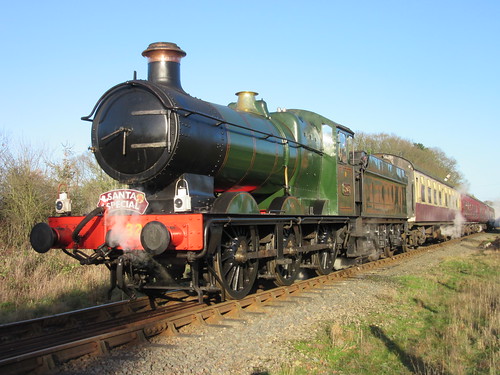 Battlefield Line 'Santa' Trains 2015: '3205' pauses at Market Bosworth before continuing to Shenton.
Battlefield Line 'Santa' Trains 2015: '3205' pauses at Market Bosworth before continuing to Shenton.
This class was introduced by Charles Collett in 1930 as a replacement for the much-loved and long-lived 'Dean Goods' and Armstrong 0-6-0 tender locomotives. The 'Dean Goods' was introduced by William Dean in 1883 and by 1899 260 off had been completed.
The Collett locomotive proved versatile, handling goods, short-distance main line and stopping passenger trains. The design had two inside cylinders, each 17.5 inches diameter by 24 inch stroke, fed from slide valves controlled by Stephenson Link Motion. With 5 foot 2 inch diameter coupled wheels, tractive effort was 20,155 pounds. Whilst the 'Dean Goods' had no route restrictions, the heavier axle load of the '2251' (a little over 15 tons) gave them a 'Yellow' route colour. Swindon Standard Boiler Number 10 was produced for the class - a tapered, Belpaire boiler pressed to 200 p.s.i. with superheating and a sloping grate of 17.4 square feet area. Subsequently, the Number 10 Boiler was used by Collett's successor, Frederick Hawksworth in the '9400' 'Pannier' and the '1500' outside-cylindered 'Pannier' locomotives.
In the design of the '2251', Collett followed the standards introduced by Churchward so construction and driving controls are largely similar to other Great Western engines. The '2251' has a screw reverser, rather than a lever reverser. Like most of the Great Western tank engines, the locomotive is fitted with a steam brake, combination brake valve, vacuum ejector and vacuum pump. When shunting light engine using just the steam brake, the driver has to first ensure that the vacuum brake on the standard tender is released.
Events of Wednesday 23rd December 2015
Wednesday's 'Santa' timetable called for fewer services than on my turn the previous Saturday: '3205', the 'Collett Goods', was booked to make two trips to Shenton (leaving Shackerstone at 11 a.m. and 3 p.m.) whilst 'Cumbria' was diagrammed to make one trip (at 1 p.m.).
Adrian L. was the other driver and he generously suggested I took '3205' knowing I'd not previously driven the class, assuring me "You'll like it" (Of course, he was right. I was once asked 'What's your favourite engine?' An old engineman present commented 'Anything they'll let her drive!').
Dave H. was once again marked as fireman with Jamie as Trainee. Since Jamie was very close to passing out as a Fireman, Dave let him perform most of the firing. Whilst Dave and Jamie lit the fire, I went round the engine examining, oiling and familiarising myself with the layout.
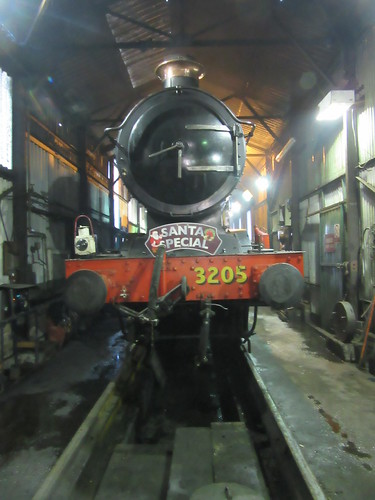
'3205' being prepared inside the shed at Shackerstone.
I found one cork missing from an Expansion Link, which we replaced from a small stock in the toolbox on the tender, otherwise everything seemed to be in order. Having been used the previous day, the engine came into steam fairly quickly.
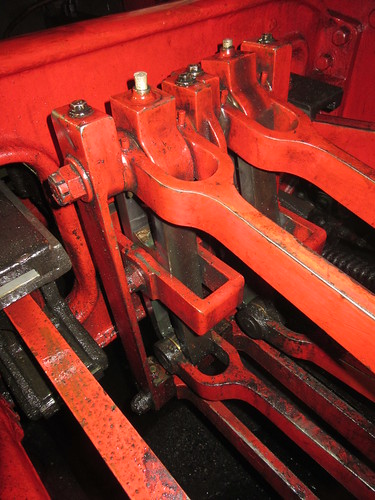
View looking forwards on the left side of engine. Motion Plate (top) L-R: Rear of slide bars and LH Connecting Rod, LH Lifting Links and Expansion Link (showing attachment of Valve Rod to Die Block), RH Lifting Links and Expansion Link. Forward Eccentric Rods connect to top of Expansion Link, Back Eccentric Rods connect to bottom of Expansion Link.
The Great Western, like most railways, made their tenders interchangeable, so '3205' was actually running with the tender from previous-visitor to Shackerstone '3803' which I'd last seen in black livery. There are a number of posts on '3803', such as Easter Saturday at the Battlefield Line. The tender tank had been filled using the water hose in the shed and the water gauge on the tender indicated that we had the full 3,000 Gallons (although being float-operated such gauges are not always truthful). With only two round trips, we didn't need to trouble the water column on platform 2 during the day.
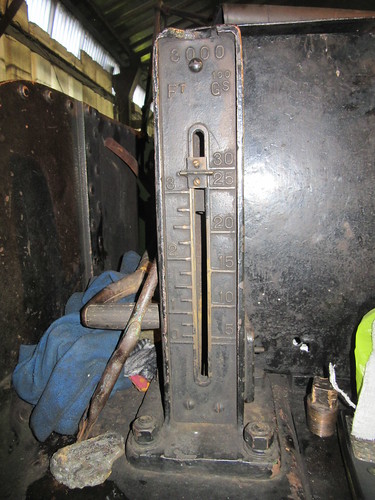
Float-operated water gauge on tender, marked in Feet and Gallons.
We came off-shed, moved across to our train in platform 2, coupled on and commenced steam heating. On the Fireman's side of the cab, a Carriage Warming Isolating Cock is connected to the steam manifold, receiving full boiler pressure. This feeds a Mason's Reducing Valve, allowing the steam pressure fed to the train to be regulated.
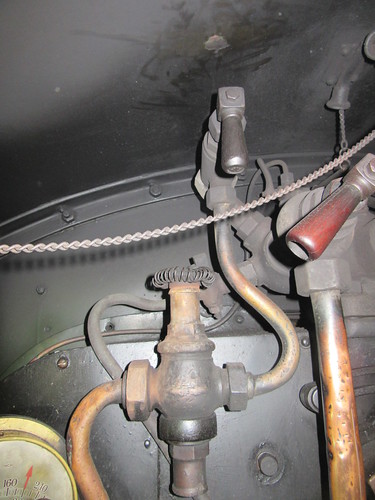
Wooden-handled steam isolating cock for Carriage Warming (top), feeds a Mason's Reducing Valve (bottom) for regulating the pressure.
A Bourdon Gauge (similar to the Boiler Pressure Gauge) indicates the carriage warming pressure being fed to the train. The engraved brass dial on G.W.R. carriage warming pressure gauges lists the pressure to be used according to length of the train.
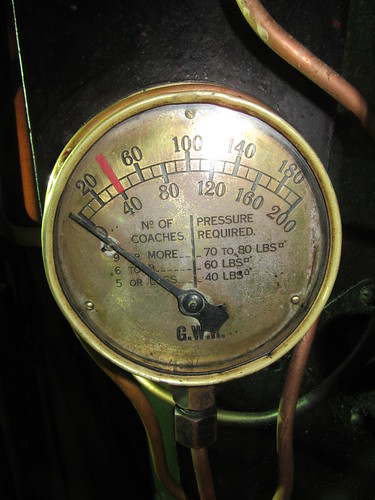
Carriage Warming Pressure Gauge showing pressure to be used according to length of train.
As expected, departure was a little late, waiting for passengers. On receipt of the Guard's 'right away', I checked the signals, whistled and, with the screw reverser set to full forward gear (about 75% cut-off indicated) and the cylinder drain cocks open, eased the regulator open. After a few yards, I closed the drain cocks. We collected the Single Line Staff from the signalman and made our way up the bank, observing the 10 m.p.h. speed limit. By this time, I'd wound the reverser back to around 35% cut-off, at which the engine appeared quite happy. Once clear of the speed restriction, I only allowed speed to rise a little as Santa trains are always leisurely as groups of passengers are led through the train to visit Santa.
Once we were on the downgrade to Market Bosworth, I was able to shut off steam. I banged the regulator shut, to make sure it had closed, and then gently moved the regulator handle open far enough for curved link lifted by the regulator handle to open the Jockey Valve so that the Sight Feed Lubricator would continue to feed oil to the moving pistons and valves. I also wound the reverser to full forward gear - the 'Drift' position which suits most locomotives fitted with Stephenson Link Motion. A little braking as we approached the platform at Market Bosworth reduced our speed then I used a little steam to ease the whole train into the platform before stopping. The fireman wound the tender handbrake on as we were likely to stand a little while. We took the opportunity to take a few photographs.
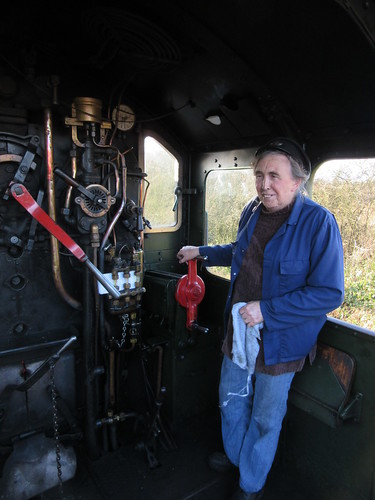
Dave took this picture of Jan as we waited at Market Bosworth.
When we received the 'right away', starting away was generally similar to leaving Shackerstone - there's a 5 m.p.h. slack over the foot crossing until past the out-of-use signal box then a further slack of 5 m.p.h. over the underbridge near the siding. Once clear of this slack, I used a little more steam to climb the bank, again with about 35% cut-off but running at a very modest speed.
I was able to 'drift' on the downgrade to Shenton, bring our speed down with gentle braking on the approach and a little steam to bring the train into the station. With vacuum destroyed, I 'eased-up' onto the train to make uncoupling easier then made the locomotive safe for 'going between' to uncouple - tender handbrake hard on, regulator fully shut, reverser in mid-gear, cylinder drain cocks open. After uncoupling and with one lamp on the buffer beam at each end, we ran around the train and coupled on again, setting the lamps to 'Express' (one over each buffer on the tender).
Soon we were making our leisurely progress back to Market Bosworth, tender first. It can be unpleasant running tender first with the wind and when it rains - well! There was a canvas storm sheet available which can be rigged between the cab roof and two supports at the front of the tender but it was not needed as we were lucky with the weather. Once again, we stood for some minutes in Market Bosworth, so I took the picture below.
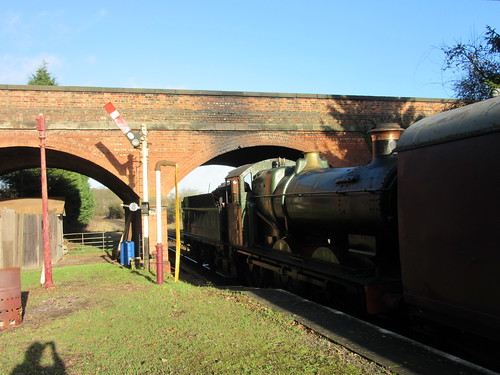 Battlefield Line 'Santa' Trains 2015: '3205' waits for the 'right away' from Market Bosworth.
Battlefield Line 'Santa' Trains 2015: '3205' waits for the 'right away' from Market Bosworth.
When we arrived back at Shackerstone (unfortunately stopping a little short because of a problem releasing the train brakes after an application), 'Cumbria' was ready to leave with the 'De Luxe' service. Once all our passengers had disembarked, I positioned the train correctly and we ran round, ready for the 3 p.m. departure.
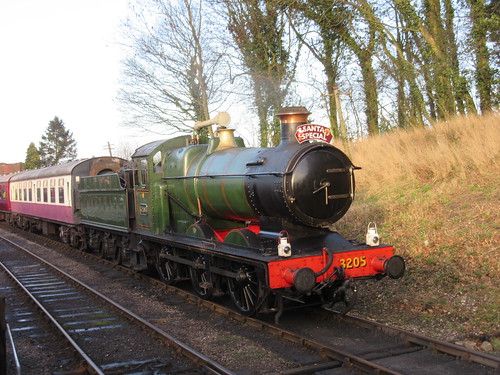 '3205' ready to take the 3.00 p.m. from Shackerstone on 23rd December 2015.
'3205' ready to take the 3.00 p.m. from Shackerstone on 23rd December 2015.
The 3.00 p.m. train was a little late away and we made the usual unhurried progress to Shenton, pausing at Market Bosworth for a while. By the time we had run round, it was dusk, so we made sure the loco lamps were lit (there's a short article on traditional lamps MIC - Lamps). Once again, we were held at Market Bosworth in the gathering gloom but this time the Guard, before issuing the 'right away' using a handlamp, gave us the instruction "Go for it!". Of course, '3205' worked the train up to line speed without effort and, all too soon, we were approaching Shackerstone and looking out for the Outer Home signal.
Although the signals at Shackerstone are semaphore and were originally lit by paraffin (there's an article about semaphore signals at night here), they have been adapted and are now electrically lit. The signalman had "given us the road" so we gingerly descended the bank, surrendered the Single Line Staff and stopped in platform 2 (this time in the right place). We quickly uncoupled and dropped forward clear of the points to await our path to the shed, which was blocked by the 'De Luxe' train stock. The picture below gives an idea of how dark it had become. You can just see the right hand side of '3205', ahead of us the last coach of the 'De Luxe' train and on the right the passengers off our train, streaming past to the car park.
Adrian had already disposed of 'Cumbria' in the shed but, in its place, he'd attached a diesel shunter which performed the final shunt I'd carried out using 'Cumbria' on Saturday 19th December 2015. Once the coaches had been drawn up towards the single line, we were able to make our way through platform 1 to the 'Dock' ground frame and into the shed. We quickly disposed, I completed the necessary paperwork and thanked Dave and Jamie for a splendid day.

Not yet 5.00 p.m. but already dark: View from the footplate of '3205' (left) as we wait for the empty stock ahead of us to be drawn clear so that we can reach the shed. Happy passengers (right) stream past to the car park.
You can find all my posts on 'Santa Special' trains here.
My pictures of Battlefield Line 'Santas' in 2015
Battlefield Line 'Santa' Trains 2015.
